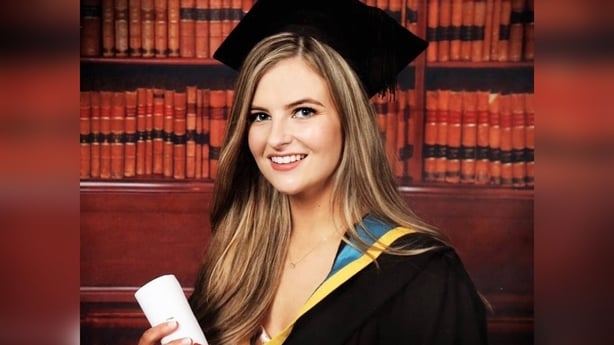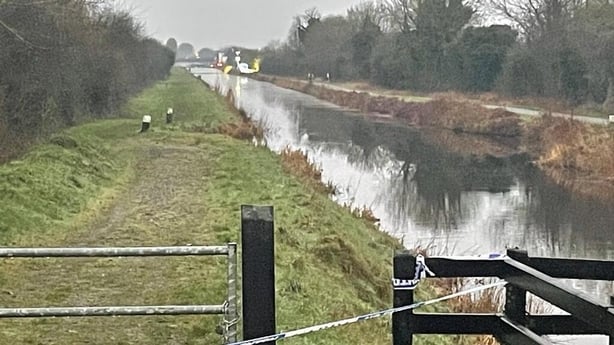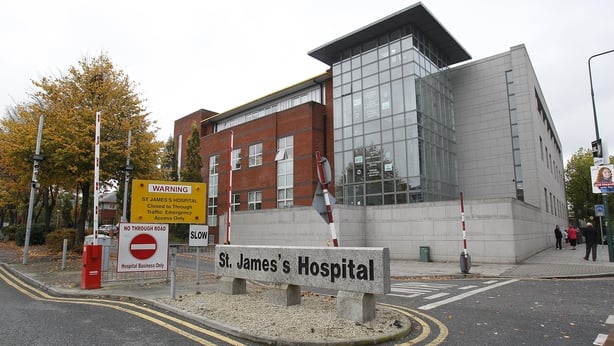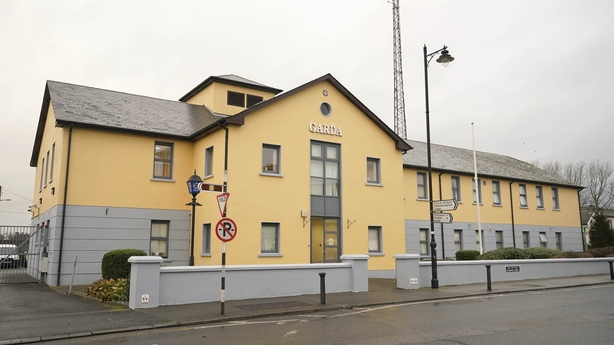The first time Ann Marie Kelly saw the footage of Jozef Puska cycling behind her as she walked her dog, was as she sat in the witness box of Courtroom number 13 in the Criminal Courts of Justice.
Ms Kelly who is also a primary school teacher, like Ashling Murphy, was out for a walk with her dog on the afternoon of 12 January last year.
Shortly before 2pm, the CCTV footage which had already been shown to the jury, picked up Ms Kelly crossing Church Road with her dog.
Mr Puska could be seen on his bicycle shortly afterwards going in the same direction.
Ms Kelly, who is blonde and of average height, identified herself on the footage of a bright and sunny afternoon.
She told the jurors she was passing McDonald's when she felt someone very close to her.
She turned around and saw a man cycling a bicycle very slowly behind her and staring directly at her.
Although she stepped in to let him pass, she told the court he would not pass.
She felt very uncomfortable and stopped to look at her phone so the man would have to pass her.
She said he did so in "really, really slow motion", looking back over his shoulder, staring directly at her.
"It felt like an intimidating stare," she told the jurors.
Ms Kelly saw the man again at the Grand Canal, an encounter that was not captured by CCTV. He was holding his bicycle and looking at her.
She made what she described as a quick decision, "maybe a foolish one" to walk along the grassy side of the canal rather than on the pathway at the other side, hoping he would not be able to follow her on his bike.
But she noticed he was "walking quite fast" behind her with the bicycle.
She got to a white van and noticed he was maybe a foot behind her.
Ms Kelly described stopping and allowing him to pass her again, which she said he did "very, very slowly".
She then decided to put her head down and jog on past him, conscious she said, not to make eye contact or engage with him.
Ms Kelly was cross-examined by defence counsel, Michael Bowman, who put it to her that Mr Puska remembered passing her and looking at her.
But that he did not believe he had stared at her and never intended to stare at her.
She told him "that’s what I saw. He was staring at me". Mr Bowman said Mr Puska may have been in close proximity to her but was not following her.

"He appeared like he was following me," Ms Kelly said.
Ms Kelly was asked about other people she met on her walk afterwards.
She said the last person she met was a "lovely, friendly girl," in her mid-20s, with "blondey-browney" hair, wearing a peachy coloured hat.
She described this girl as smiley and chatty and said she was talking to Ms Kelly about her dog, Joey and petting him for a bit.
The jury had already been shown the light pink coloured bobble hat that Ashling Murphy was wearing on the day.
Another woman, Beata Barowska, also identified herself on CCTV footage.
Ms Barowska, who is also blonde, had been walking to Tesco in Tullamore a little earlier on the same day.
Mr Puska can be seen cycling behind her. However Ms Barowska told the court she had no awareness of anyone behind her.
The Fitbit
Ashling Murphy’s Fitbit watch showed that she began exercising at 2.51pm on that same afternoon.
Detective Garda Ciaran Byrne analysed the data gleaned from the device.
He said the watch allowed them to plot the route taken by Ms Murphy, as well as her speed and her heart rate.
After parking in the Daingean Road car park, she walked for almost 3 kilometres in an easterly direction along the canal.
When she reached Digby Bridge at 3.16pm, the watch showed she turned around to travel back in the direction she had come.
She was walking briskly, the court heard at a pace of nine or ten minutes a kilometre. But at 3.21pm, everything changed.
Garda Byrne’s graph plotting her direction showed that from that point on, the watch was no longer travelling in a westerly direction.
It was showing erratic or violent movement he said, the bearing swaying quickly from zero to 360 degrees in a constant manner.
Garda Byrne’s representation of Ms Murphy’s heart rate remained on screen while he finished his evidence and was cross examined.
It showed her heart was raised for a consistent period of time as she walked, up until 3.21pm. It then decreased rapidly until 3.27pm.
There was a slight increase at that point but at 3.31pm, the watch was no longer picking up a heart rate.
Under cross-examination, it was put to Garda Byrne that the accuracy of values recorded by the watch could vary by plus or minus 10% and it was also put to him that the company specifically said the device was not intended to provide scientific data.
The family friend
On Tuesday, the court heard evidence from a friend of the Puska family.
Rostislav Pokuta is also originally from Slovakia but has lived in Ireland since 2006.
He drives buses he told the court and manages other bus drivers, bringing children to and from school.
Mr Pokuta made two statements to gardaí in the aftermath of Ms Murphy’s murder.
After some initial discussion about dates, Mr Pokuta told the court about matters he had left out of his first statement but had told gardaí about in his second statement.
He said Jozef Puska had come to his door at around 9pm on the night of 12 January last year and asked him to drop him home to Mucklagh.
He described Mr Puska as being wet and shaking.
He said he looked very scared and his face was scratched and bleeding.
When he asked Mr Puska what had happened, Mr Pokuta said he told him he "had some fight, or something else in town".
He said he didn’t really want to talk too much.
When they got to Mucklagh, he said Mr Puska asked him to slow down in case someone was outside his house and to drop him a little further down the road.

But he said he "dropped him down to the house exactly."
Under cross-examination, he was asked if he had noticed if Mr Puska looked hurt or was holding his stomach when he arrived at his house. Mr Pokuta said he thought so.
Mr Bowman agreed with Mr Justice Tony Hunt that on instructions from his client, it was being suggested that Mr Puska had an injury already when he arrived at Mr Pokuta’s house.
Mr Pokuta told the court he had not told the full story in his first statement because of the mood around Tullamore at the time.
He said it was more than ugly. He said he was worried for his own children and that people would not trust him to drive their children to and from school.
Evidence from Dublin gardaí
Gardaí from Crumlin and Blanchardstown gave evidence about their dealings with Jozef Puska in Dublin the following day.
Gardaí from Crumlin were called to an apartment block on the morning of 13 January and told there had been a stabbing.
Garda Keith Brennan said Mr Puska was in a bedroom. He appeared to be in pain and there were clear markings on his face.
He told gardaí he had been stabbed in Blanchardstown the previous day.
Garda Brennan said Mr Puska’s cousin who was in the apartment and helping to translate, told him Mr Puska’s wife had told her the previous evening that she had tried to go to the garda station and report him missing.
Mr Puska was taken to St James’s Hospital. There had been a stabbing the previous night in Blanchardstown so gardaí from that area came to the hospital to speak to him.
He told them that he had come from Tullamore by car, that he got a taxi from Heuston Station to Blanchardstown to meet a woman and that he was set upon by two men as soon as he got out of the taxi.
But he could not tell them who his friend was, he could not identify the woman or her address and he could not identify his attackers beyond saying that one of them was dark.
It did not add up and Tullamore gardaí were alerted.

The "confession"
Gardaí from Tullamore arrived at the hospital that evening but were told by his treating doctor that Mr Puska was having an operation.
On the evening of 14 January, they were granted a search warrant in the Criminal Courts and returned to the hospital.
Sergeant Brian Jennings told the court about his conversation with Mr Puska that evening.
He said he told Mr Puska they were investigating Ashling Murphy’s murder and Mr Puska asked if he was a suspect, Sergeant Jennings said he told him he was a "person of interest".
The sergeant told the court there was a "notable pause" and Mr Puska spoke with the interpreter.
The interpreter then told gardaí that Mr Puska wanted to make an official statement and wanted him to translate word for word, telling gardaí Mr Puska said: "I did it. I murdered. I am the murderer".
Sergeant Jennings cautioned Mr Puska and tried to stop him talking he said, but Mr Puska continued, saying he was pleading guilty because he did not want anything bad to happen to his family, that he felt guilty and he regretted it.
He said he did not do it intentionally and asked if his family would be safe.
The interpreter, Miroslav Sedlecek, told the court Mr Puska sounded emotional and his voice was trembling at this stage.
He said he would describe Mr Puska as being in very low spirits after the confession. "I would even say desperate," he said.
Afterwards, Mr Puska spoke to another garda, Fergus Hogan who gave evidence that Mr Puska told him "when she passed, I cut her, I cut her neck, she panic, I panic" and also said that he had caused his own injuries.
The court heard that at this time the details of how Ms Murphy had been killed had not been made public and Garda Hogan said he himself did not know she had been stabbed.
The gardaí described Mr Puska as alert and awake during their interactions with him.
They said they had not made a direct inquiry about whether or not he was fit to be interviewed and had not asked to speak to his treating doctor.
The other suspect and DNA evidence
Tullamore gardaí had arrested another man on suspicion of the murder of Ashling Murphy on 12 January but at 10.30pm on the night of 13 January, the court was told this other man was released, after DNA samples taken from him did not match DNA found on a bicycle at the scene and under Ms Murphy’s fingernails and his fingerprints were not a match for a print found on the saddle of the bike.
Fingerprint expert Sergeant Damien Carroll said after his analysis he was in no doubt that the print from the underside of the saddle was made by the ring finger of Jozef Puska’s right hand.
Forensic scientist John Hoade took samples from the handlebars of the bicycle and compared them to samples taken from Mr Puska.
They matched he said, and there was a one in a billion chance of the DNA coming from someone other than Mr Puska.
His colleague, Dr Lorna Flanagan analysed the DNA found under Ms Murphy’s fingernails.
She described carrying out male specific DNA profiling in order to separate the male DNA from Ms Murphy’s own DNA.
Her analysis she said showed the profile she generated from the fingernail scrapings matched profiles generated from Mr Puska’s samples.
There was a one in 14,000 chance of this coming from someone unrelated to Mr Puska she said.
She said the database of samples used by Forensic Science Ireland took into account "all different ethnicities" in Europe, including, she said in answer to a question from Defence Counsel, Michael Bowman, ethnic Romany Slovaks.

The arrest
Jozef Puska was arrested on his release from St James’s Hospital on 18 January, the court heard.
Detective Sergeant David Scahill gave evidence of bringing him to Tullamore Garda Station, arriving at around 12.30pm.
He told the court Mr Puska was charged with the murder the following evening and his reply after being cautioned was "no".
Under cross examination, he told the court it was not widely known that Mr Puska was going to be arrested and he did not recall a crowd of people outside Tullamore Garda Station.
Garda Ciara Martin who was the member in charge at Tullamore was also asked about a crowd outside the station.
Mr Bowman asked her if she had left the station at any time to get a cup of tea "or a biscuit".
Mr Justice Tony Hunt intervened to comment on the line of questioning, saying "this trial is about what happened in the ditch" and telling Mr Bowman that he "seemed to be at the far reaches of relevance".
What happens next?
The judge has already told the jury that the case should finish completely by Friday 10 November.
As they prepared to head home for the long weekend, he told the nine men and three women that the prosecution case may finish in "another day or two", by the middle of next week.
The judge also told them he did not know what would happen after that.







